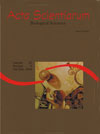Scientometric analysis in population ecology: importance and trends over the last 60 years
Abstract
The aim of this paper was to carry out a scientometric analysis in population ecology. We seek to understand the importance and trends of that population ecology field throughout years, connecting them with the principal geopolitical regions around the world. To that end, a bibliographic survey at Thomson ISI web site was carried out, at the period between 1942 and 2005, using the key-word “population ecology”. Data showed an exponential growth in the number of publications on population ecology, most of them developed in USA and Europe and publicized in ecological journals of wide international distribution and high Citation Index. A Principal Component Analysis (PCA) showed distinct temporal trends in population ecology researche, leading to more recent decades (1990 and 2000, until 2005) a great variety of organisms studied and related with other ecology fields (conservation biology and community ecology) and natural sciences (biogeography, genetics, evolution, epidemiology and demography). These results contrast with the scientific stagnation widely criticized in ecology and indicate the progress of the population ecology as science, persuing new horizons as well as new paradigms, laws, theories and principles that might be useful to the society.Downloads
Download data is not yet available.
Published
2007-11-16
How to Cite
Ribeiro, M. de S. L., Nabout, J. C., Pinto, M. P., Moura, I. O. de, Melo, T. L. de, Costa, S. S., & Rangel, T. F. L. V. de B. (2007). Scientometric analysis in population ecology: importance and trends over the last 60 years. Acta Scientiarum. Biological Sciences, 29(1), 39-47. https://doi.org/10.4025/actascibiolsci.v29i1.125
Issue
Section
Ecology and Limnology
DECLARATION OF ORIGINALITY AND COPYRIGHTS
I Declare that current article is original and has not been submitted for publication, in part or in whole, to any other national or international journal.
The copyrights belong exclusively to the authors. Published content is licensed under Creative Commons Attribution 4.0 (CC BY 4.0) guidelines, which allows sharing (copy and distribution of the material in any medium or format) and adaptation (remix, transform, and build upon the material) for any purpose, even commercially, under the terms of attribution.
Read this link for further information on how to use CC BY 4.0 properly.
0.6
2019CiteScore
31st percentile
Powered by 

0.6
2019CiteScore
31st percentile
Powered by 











1.png)




3.png)













